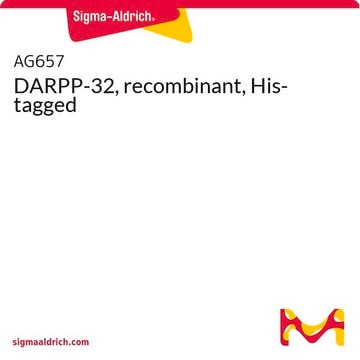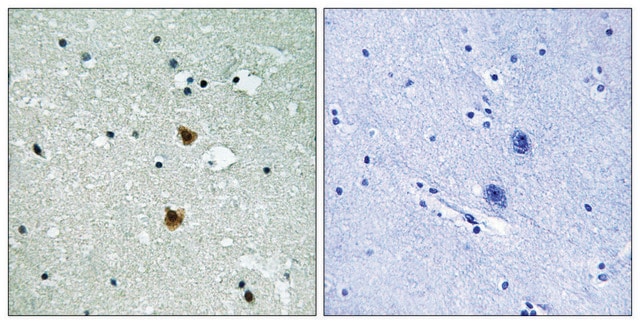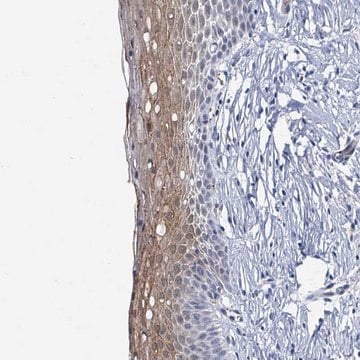おすすめの製品
由来生物
rabbit
品質水準
抗体製品の状態
affinity purified immunoglobulin
抗体製品タイプ
primary antibodies
クローン
polyclonal
精製方法
affinity chromatography
化学種の反応性
human
メーカー/製品名
Chemicon®
テクニック
ELISA: suitable
immunohistochemistry: suitable
western blot: suitable
NCBIアクセッション番号
UniProtアクセッション番号
輸送温度
dry ice
ターゲットの翻訳後修飾
unmodified
遺伝子情報
human ... DRD3(1814)
特異性
Specific for Dopamine Receptor D3. Human Dopamine D3 receptor is a 400 aa, G-protein coupled and transmembrane receptor protein (Giros et al. 1990, 1991; Schmauss et al. 1993; Liu et al. 1994; Fu et al. 1995; Sokoloff et al. 1990; Livingstone et al. 1992). The immunogen peptide shows no significant sequence similarity with other dopamine receptors (D1, D2, D4 or D5).
免疫原
A 19 amino acid peptide sequence from the human D3 receptor within the 3rd cytoplasmic domain.
Epitope: cytoplasmic domain
アプリケーション
Research Category
ニューロサイエンス
ニューロサイエンス
Research Sub Category
神経伝達物質及び受容体
神経伝達物質及び受容体
Detect Dopamine D3 Receptor using this Anti-Dopamine D3 Receptor Antibody, cytoplasmic domain validated for use in ELISA, IH & WB.
Western blot: 1-10 μg/mL (Chemiluminescence technique) Approximately 100-400 μg of membrane protein/lane should be loaded to visualize the receptor band.
Immunohistochemistry: 1-20 μg/mL on paraformaldehyde fixed sections.
ELISA: 0.5-1.0 μg/mL (1 μg/mL immunogen peptide (Cat. Number AG224)/well)
Optimal working dilutions must be determined by the end user.
Immunohistochemistry: 1-20 μg/mL on paraformaldehyde fixed sections.
ELISA: 0.5-1.0 μg/mL (1 μg/mL immunogen peptide (Cat. Number AG224)/well)
Optimal working dilutions must be determined by the end user.
物理的形状
Affinity purified immunoglobulin. Liquid in PBS, pH 7.5 with 0.1% BSA. No preservatives
保管および安定性
Maintain at -20°C in undiluted aliquots for up to 12 months. Avoid repeated freeze/thaw cycles.
法的情報
CHEMICON is a registered trademark of Merck KGaA, Darmstadt, Germany
免責事項
Unless otherwise stated in our catalog or other company documentation accompanying the product(s), our products are intended for research use only and are not to be used for any other purpose, which includes but is not limited to, unauthorized commercial uses, in vitro diagnostic uses, ex vivo or in vivo therapeutic uses or any type of consumption or application to humans or animals.
Not finding the right product?
Try our 製品選択ツール.
保管分類コード
10 - Combustible liquids
WGK
WGK 2
引火点(°F)
Not applicable
引火点(℃)
Not applicable
適用法令
試験研究用途を考慮した関連法令を主に挙げております。化学物質以外については、一部の情報のみ提供しています。 製品を安全かつ合法的に使用することは、使用者の義務です。最新情報により修正される場合があります。WEBの反映には時間を要することがあるため、適宜SDSをご参照ください。
Jan Code
AB1785P:
試験成績書(COA)
製品のロット番号・バッチ番号を入力して、試験成績書(COA) を検索できます。ロット番号・バッチ番号は、製品ラベルに「Lot」または「Batch」に続いて記載されています。
Vijay Chandrasekar et al.
Molecular and cellular neurosciences, 42(4), 350-362 (2009-08-26)
MicroRNAs play key regulatory roles in cellular processes including neurogenesis, synapse development and plasticity in the brain. Psychostimulants induce strong neuroadaptive changes through a surfeit of gene regulatory mechanisms leading to addiction. MicroRNA profiling for identifying miRNAs regulating cocaine-induced, plasticity-related
Frederik Ravnkilde Marlet et al.
Biochimica et biophysica acta. Molecular basis of disease, 1870(6), 167212-167212 (2024-05-16)
Parkinson's Disease (PD) is characterised by the loss of dopaminergic neurons and the deposition of protein inclusions called Lewy Bodies (LBs). LBs are heterogeneous structures composed of protein and lipid molecules and their main constituent is the presynaptic protein α-synuclein.
Jian-Da Wang et al.
Autophagy, 11(11), 2057-2073 (2015-12-10)
Autophagy dysfunction is implicated in the pathogenesis of Parkinson disease (PD). BECN1/Beclin 1 acts as a critical regulator of autophagy and other cellular processes; yet, little is known about the function and regulation of BECN1 in PD. In this study
ライフサイエンス、有機合成、材料科学、クロマトグラフィー、分析など、あらゆる分野の研究に経験のあるメンバーがおります。.
製品に関するお問い合わせはこちら(テクニカルサービス)








